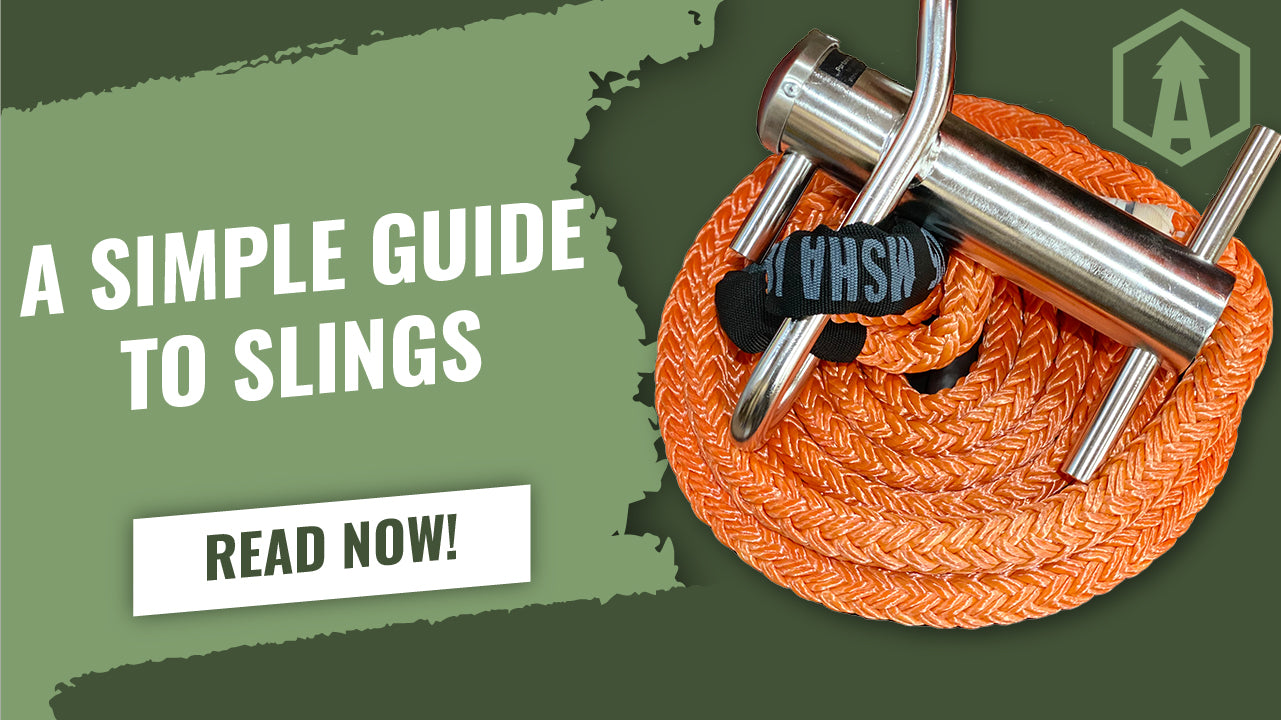
A Simple Guide to Slings
How does this sling work? When should I use this one versus the other? These are frequently asked questions that get brought up on a daily basis. So, we’re here to guide you in the right direction and help you choose the one best suited for your style. Slings have a plethora of uses in our industry ranging from climbing, rescue, rigging and removals, so using the right one can make a big difference in achieving the desired outcome.
Dead Eye Slings
We’ll begin with dead eye slings; as with anything else, they will vary in length, diameter and material but one thing they have in common: a large, spliced eye at ONE end. Hence the name, DEAD EYE SLING. The opposite end is just the bitter, no special termination needed aside from the traditional heat shrink tubing to prevent the fibers from fraying out. Dead eye slings pair beautifully with a Port-a-warp, now whether to pair or not to pair with impact blocks will be preference and situational. If you opt to go this route, you will need to know how to properly tie a Cow Hitch and a Timber Hitch. They are simple to learn and luckily for you, we’ve got you covered! Find us on YouTube and we’ll have videos on how to properly configure both of these anchor hitches. I myself prefer this style of sling and I have met plenty that will agree. Afterall, we are arborists, and we shouldn’t forget how to use knots…right!?! Too often do I see experienced professionals not know how to configure either of these traditional anchor hitches. As I mentioned before, it’s all preference. Throughout my extensive career in Arb, I have found dead eye slings easier to work with on large diameter wood, in other words, negative rigging.
Loopie Slings
It seems to me like loopie slings have been designated as the “The One” and I can see why, they’re quick, simple, and effective to use! This style sling is made from hollow braid which allows an end to be spliced back through itself, thus making a continuous loop with easy adjusting. To adjust, the user pulls on one of the legs of the inner loops and this will extend the loop, allowing the loopie to girth around a larger diameter object. Pulling on the tapered end with the label and heat shrink will, in most cases, condense the size of the loopie. Once you have figured out the length needed, take your loopie sling and girth it around the trunk, but keep in mind where the choking action is taking place. The ideal placement; have the cross-over section of the Girth pass over the adjustable section of the sling. This will ensure the sling really locks in and prevents any unwanted extension.
Ultra-Slings
During the last couple of years, ultra-slings/ultra-ring slings have gained immense popularity, or it could be that I favor blocks and pulleys. But we’ll never know. If you thought loopie slings were easy to use, these are a hundred times simpler! The sling consists of a long length of tenex material which gets folded over, creating a dead eye and followed by splicing the ends back to each other; making “pockets”. That’s how I’ve always described it and if the terminology isn’t up to par, oh well, you know what I mean. Towards the end, you’ll end up with a thick bitter end and a load of lock stitching. This is because one of the two bitters gets spliced into the other in order to finish the sling. Ultra-Ring Slings are the same; only difference, this one has a rigging ring/ thimble at the dead eye portion.
Whoopie Sling
If you prefer loopie slings but wish they had a way of keeping the hardware parked and not floating around, the whoopie sling may be what you are searching for! Think of Whoopie slings as a cross between a loopie and a dead eye sling; they adjust like a loopie, and in the case of the dead eye sling relation; it has a dead eye at the opposite end. These are recommended at the base of the tree in conjunction with a Port-a-Wrap. They can, in my opinion, be cumbersome while aloft.
Loop Slings
Also known as endless loops, loop slings are normally made from nylon material, are compact, lightweight, and can handle some weight for their size! This style sling can be used for climbing redirects, rigging redirects, or as a light-to-mediumish sized rigging anchor point. Keeping a loop sling, carabiner and a DMM Pinto Rig on my harness eliminates the need for a big bulky harness when we have a trek to the jobsite. Multiple loop slings and carabiners will set you up for a speed line to increase efficiency if you are down a crew member.
Be certain to pair your rigging hardware with appropriate slings. It can be easy to misconfigure components and may lead to failure in the system.






Leave a comment